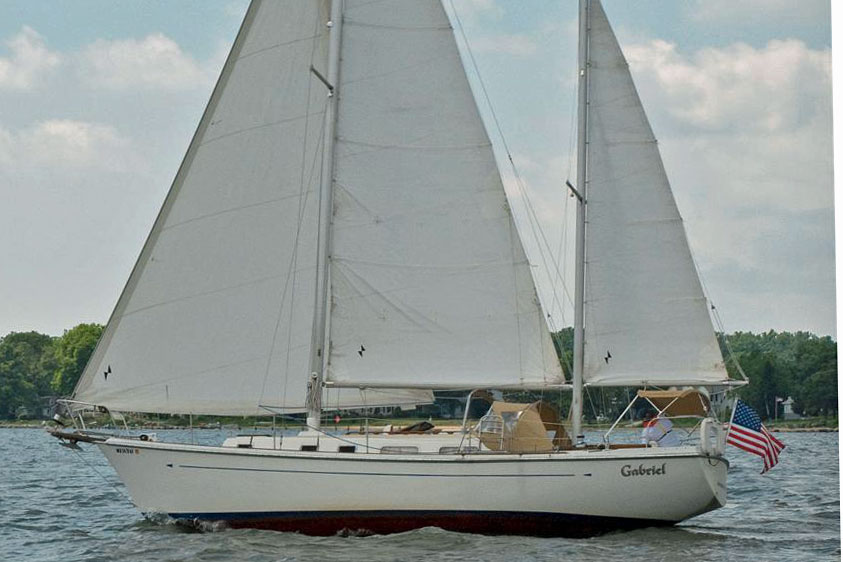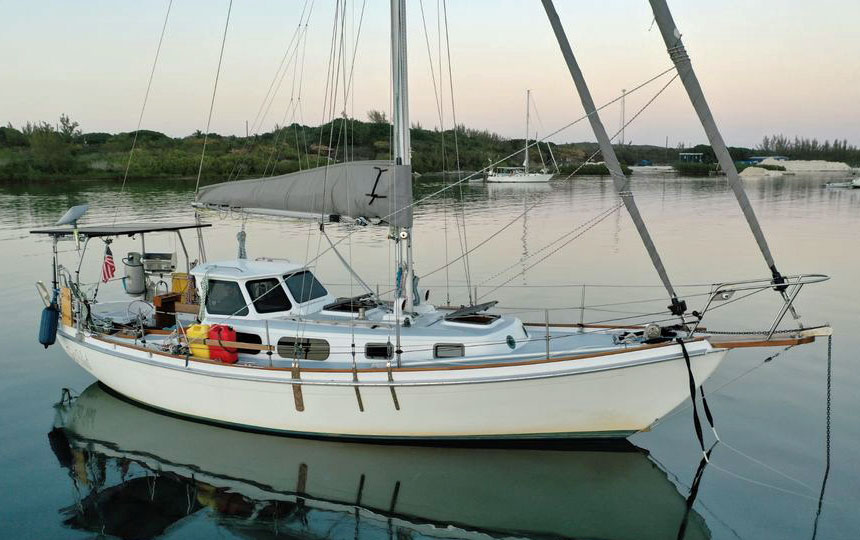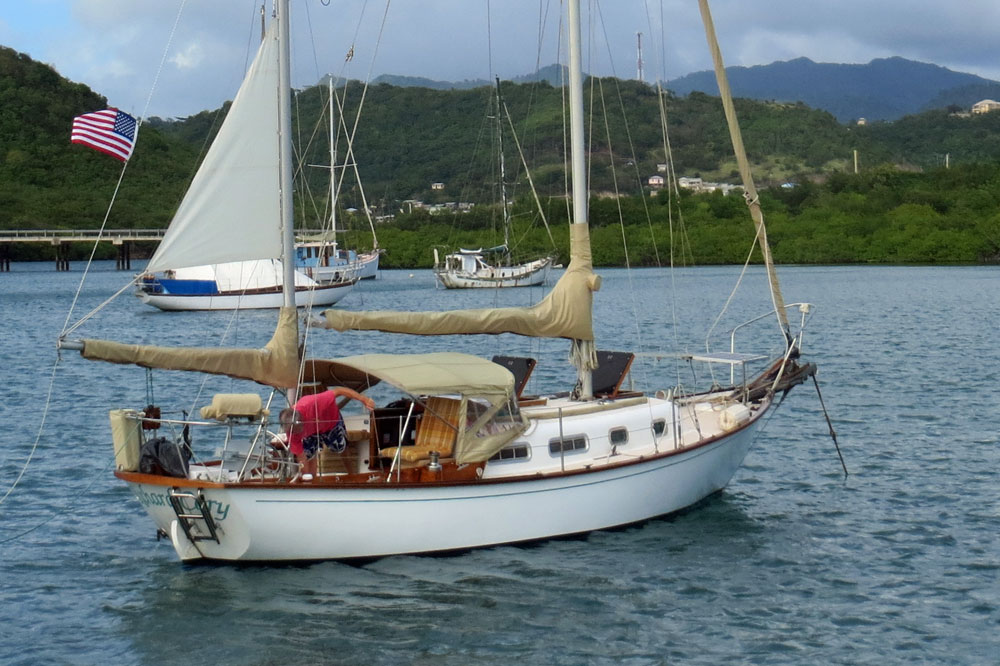- Home
- Cruising Yachts 35' to 40'
- Allied Princess 36
The Allied Princess 36
Sailboat
The Allied Princess 36 is a cruising sailboat, designed by naval architect Arthur Edmunds, an American. This vessel was built by the Allied Boat Company, which was located in Catskill, New York.
First introduced to the boat market in 1972, the Allied Princess 36 offers a monohull design that was aimed at both comfort and long-distance cruising capabilities. The design and manufacturing of the boat reflect the deep maritime knowledge and innovative boat-building techniques of the era, making it a notable model in the world of cruising sailboats.
 'Gabriel', an Allied Seawind 36 MkII ketch under full sail.
'Gabriel', an Allied Seawind 36 MkII ketch under full sail.Published Specification for the Allied Princess 36
Underwater Configuration: Full keel
Hull Material: Fiberglass
Length Overall: 36 feet (approximately 10.97 meters)
Waterline Length: 27.5 feet (approximately 8.38 meters)
Beam: 11 feet (approximately 3.35 meters)
Draft: 4.5 feet (approximately 1.37 meters)
Rig Type: Masthead ketch*
Displacement: 14,400 lbs (approximately 6,532 kg)
Designer: Arthur Edmunds**
Builder: Allied Boat Company
Year First Built: 1972
Year Last Built: 1981
Number Built: 140 units
* The Allied Princess 36 was available as a cutter or ketch. There were at least four different accommodation plans, each with a good-sized V-berth up forward, with a head behind it to port, and drawers and a hanging locker to starboard.
** Arthur Edmunds, the designer of the Allied Princess 36, also designed the Princess 36 Mk2, the Contessa 36, the Mistress 39 and the Mistress 39 Mk2.
A bowsprit was added around 1980, creating the Princess 36 MkII shown above. As with the earlier model, it was available as a cutter or ketch.
A center-cockpit version was also produced, known as the Mistress 39, but few of these were built.
Published Design Ratios for the Allied Princess 36
- Sail Area/Displacement Ratio (16.4): This ratio lies within the range of 16 to 20, indicating that the Allied Princess 36 has reasonably good performance potential. It suggests the boat is not underpowered and should be capable of making good speed under sail, assuming adequate wind conditions.
- Ballast/Displacement Ratio (34.7): This ratio is under 40, indicating that while the boat has a decent amount of ballast relative to its displacement, it might not be as stiff or powerful in standing up to the wind as boats with higher ratios. The efficacy of this ratio is somewhat dependent on the distribution and location of the ballast. Boats with deep keel ballast may exhibit better stiffness and righting ability than those with shallower ballast even if the ratio is the same.
- Displacement/Length Ratio (309.1): This places the Allied Princess 36 in the Heavy Displacement category. Heavy displacement boats are generally more stable and better suited for rough waters compared to lighter boats. They are not as quick or responsive as lighter boats but tend to have smoother passage through water.
- Comfort Ratio (30.4): The comfort ratio of the Allied Princess 36 is indicative of a motion associated with a moderate bluewater cruising boat. This suggests that it should provide a relatively comfortable ride during long passages, with lesser pronounced motion in rough seas compared to lighter racing boats.
- Capsize Screening Formula (1.8): This low value suggests that the Allied Princess 36 is quite stable and has a lower risk of capsizing compared to boats with higher values. It indicates good suitability for ocean passages where the boat might encounter rough seas.
Theoretical Nature and Limitations:
- The Ballast/Displacement Ratio does not account for the location of the ballast, which can significantly influence the actual stability and stiffness of the boat. A boat with a higher ratio but poorly optimized ballast placement could perform worse than one with a lower ratio but better placement in terms of stability and righting capabilities.
- The Comfort Ratio, as designed by Ted Brewer, tends to favor traditional boat designs with heavy displacement and might not accurately reflect the comfort of modern light-displacement boats that are designed to be stable due to their hull design and other engineering features.
Understanding these limitations and the nature of these theoretical ratios is crucial for a clearer picture of the boat’s capabilities and comfort in various sailing conditions. Overall, the Allied Princess 36 appears to be a sturdy, moderately comfortable cruiser with a reasonable balance of performance and stability, making it suited both for coastal cruising and longer bluewater passages.
Read more about Design Ratios...
This article was written with the assistance of Gemini, a large language model developed by Google. Gemini was used to gather information, summarize research findings, and provide suggestions for the content and structure of the article.
Reviews of the Allied Princess 36
Practical Sailor says: "The Princess has a shoal draft, full keel, drawing just 4′ 6″. Clearly, this boat is not going to point as high as a good fin keel design, but for cruising, especially in the shallow waters of the Chesapeake, Florida and the Bahamas, it’ll be ideal. Plus, with the rudder hung off the trailing edge of the keel, the boat shouldn’t suffer too much damage in the event of a grounding." Read more...
Sailing Magazine says: "The Princess 36 was designed for cruising and it looks the part. David Humphreys, who sails his 1980 Princess Mk2 Gabriel in Chesapeake Bay, was smitten with the boat’s overall lines and its plentiful rigging." Read more...
Other sailboats in the Allied range include:
 The Allied Seawind 32
The Allied Seawind 32Recent Articles
-
Hans Christian 43: Classic Bluewater Cruiser & Liveaboard Sailboat
Dec 10, 25 04:37 AM
Explore the Hans Christian 43: a legendary heavy-displacement, long-keel sailboat. Read our in-depth review of its specs, design ratios, and suitability for offshore cruising and living aboard. -
Planning Your Sailboat Liveaboard Lifestyle: An Ocean Sailor's Guide
Dec 06, 25 05:18 AM
Seasoned sailors share their methodical risk analysis for planning a secure Sailboat Liveaboard Lifestyle, covering financial, property, and relationship risks. -
Marine Cabin Heaters: The Expert’s Guide to Comfort & Safety at Sea
Dec 05, 25 06:52 AM
Choose the best Marine Cabin Heaters for your vessel. Expert advice on diesel, paraffin, and hot water systems for year-round cruising comfort.













